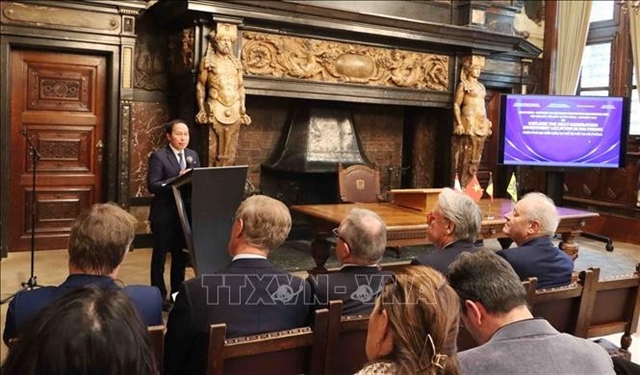 Society
Society

Provinces in the Mekong Delta have run out of sand for construction at a time when many key infrastructure works are in progress.
 |
| Sand shortage and increased sand price will affect many construction projects in the Mekong Delta region. - Photo https://cafeland.vn |
HCM CITY – Provinces in the Mekong Delta have run out of sand for construction at a time when many key infrastructure works are in progress.
The Trung Lương – Mỹ Thuận Expressway is the worst sufferer after having restarted in 2015 with a new budget of VNĐ14 trillion (US$622 million), the Thời báo Kinh tế Việt Nam (Vietnam Economic Times) reported. Work has ground to a complete halt due to lack of sand.
The project investor has asked the two Mekong provinces of An Giang and Đồng Tháp for six million cubic metres of sand, and if it is not delivered, the project’s cost will surely increase and it will not finish by 2020 as scheduled.
The Lộ Tẻ - Rạch Sỏi road with the Vàm Cống Bridge is expected to create a western corridor in the delta, linking south-eastern provinces, HCM City and the delta, even Kiên Giang and Cà Mau.
While the bridge is 90 per cent finished, the road work is tardy because construction sand prices have risen by four or five times.
The builder said even though it is willing to accept a loss because of this, there is just not enough sand available, and added the 2018 deadline would be impossible to meet.
National Road No 60 and a road from Rạch Miễu Bridge in Bến Tre Province to Cổ Chiên Bridge in Vĩnh Long Province face a similar fate.
Every day their construction unit requires more than 700cu.m of sand but only 100cu.m are provided, the Vietnam Economic Times reported.
The roads need 1.5 million cu.m of sand, whose cost has now increased to VNĐ100 billion ($4.4 million).
The director of the Bến Tre Department of Construction said that all 208 public works in the province would suffer losses and be delayed because of the sand shortage.
This year the prices of sand for making concrete have increased from VNĐ350,000 ($15.5) per cubic meter to VNĐ800,000 ($35) in the delta.
In HCM City, the price is even higher and it is expected that sand prices will keep rising, especially at the end of this year.
“Sand prices have increased by two-three times and there is not enough sand for construction,” Lâm Quang Thi, deputy chairman of the An Giang Province People’s Committee said as quoted by the Việt Nam Economic Times.
Secretary of Sóc Trăng Province’s Party Committee Nguyễn Văn Thể said if the sand shortage and sand price hike were not resolved, State-invested projects would stagnate for years.
Solutions
At a recent meeting between Deputy Prime Minister Trịnh Đình Dũng and the Southwestern Steering Committee, the sand shortage was discussed to find solutions.
Deputy Minister of Transport Nguyễn Nhật said the supply now only meets 20 per cent of the demand and urged the Government to instruct related ministries, industries and localities to open new sand mines or increase mining to meet the demand in the delta.
Lâm Quang Thi, deputy chairman of the An Giang People’s Committee, said there is plenty of sand available for mining in An Giang and Đồng Tháp.
The reason for the sand shortage in the delta is the Government’s crackdown on sand mining, he said.
Prof Dr Lê Anh Tuấn of Cần Thơ University’s Climate Change Institute said over-exploitation of sand had created deep holes in the Mekong River and was the reason for land subsidence in the delta.
“Every year the Mekong Delta loses around 500ha of land due to land subsidence and hundreds of families lose their homes and fields.”
He also noted that in the near future when all 11 dams on the upper Mekong are completed, there would be no more alluvium coming to the delta.
“If we continue increasing mining in old places and open more new mines, one third of the Mekong Delta will disappear before 2050.
“We can buy sand from Cambodia [instead].
There are various alternatives to sand for construction like solid waste like clinker and mud from thermal electric plants and shipyards.
“It will be great if we can use solid waste from thermal power plants and shipyards to replace sand in construction,” Tuấn said.
The HCM City construction department is investigating the sharp increase in sand prices this year.
It said enterprises should use plaster clinker to replace sand for construction. — VNS




